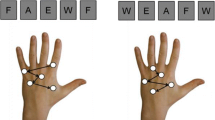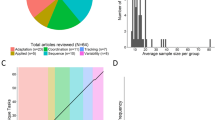Abstract
Practicing a motor task under dual-task conditions can be beneficial to motor learning when the secondary task is difficult (Roche et al. in Percept Psychophys 69(4):513–522, 2007) or when it engages similar processes as the primary motor task (Hemond et al. in J Neurosci 30(2):650–654, 2010). The purpose of this pilot study was to determine which factor, difficulty level or engaged processes, of a secondary task is more critical in determining dual-task benefit. Participants practiced a discrete arm task in conjunction with an audio-vocal reaction time (RT) task. We presented two different RT tasks that differed in difficulty, simple versus choice (i.e., more difficult), at two different arm task phases that differed in engaged processes, preparation versus execution, resulting in four dual-task conditions. A simple RT task is thought to predominantly engage motor execution processes, therefore would engage similar processes as the arm movement task when it is presented during the execution phase, while a choice RT task is thought to engage planning processes and therefore would engage similar processes too when it is presented during the preparation phase. Enhanced motor learning was found in those who engaged similar process as the primary task during dual-tasking (i.e., choice RT presented during preparation and simple RT presented during execution). Moreover, those who showed enhanced learning also demonstrated high dual-task cost (poor RT task performance) during practice, indicating that both tasks were taxing the same resource pool possibly due to engaging similar cognitive processes. To further test the relation between dual-task cost and enhanced learning, we delayed the presentation timing of the choice RT task during the preparation phase and the simple RT task during the execution phase in two control experiments. Dual-task cost was reduced in these delayed timing conditions, and the enhanced learning effect was attenuated. Together, our preliminary findings suggest that it is the similarity hypothesis and not the difficulty hypothesis that mediates the enhanced motor learning under dual-task conditions.





Similar content being viewed by others
References
Adcock RA, Constable RT, Gore JC, Goldman-Rakic PS (2000) Functional neuroanatomy of executive processes involved in dual-task performance. Proc Natl Acad Sci USA 97(7):3567–3572
Boyd LA, Linsdell MA (2009) Excitatory repetitive transcranial magnetic stimulation to left dorsal premotor cortex enhances motor consolidation of new skills. BMC Neurosci 10:72. doi:10.1186/1471-2202-10-72
Cahill L, McGaugh JL, Weinberg NM (2001) The neurobiology of learning and memory: some reminders to remember. Trends Neurosci 24(10):578–581
Chong RK, Mills B, Dailey L, Lane E, Smith S, Lee KH (2010) Specific interference between a cognitive task and sensory organization for stance balance control in healthy young adults: visuospatial effects. Neuropsychologia 48(9):2709–2718. doi:10.1016/j.neuropsychologia.2010.05.018
Cross ES, Schmitt PJ, Grafton ST (2007) Neural substrates of contextual interference during motor learning support a model of active preparation. J Cogn Neurosci 19(11):1854–1871
Fleury M, Bard C, Audiffren M, Teasdale N, Blouin J (1994) The attentional cost of amplitude and directional requirements when pointing to targets. Q J Exp Psychol 47A(2):481–495
Guadagnoli MA, Lee TD (2004) Challenge point: a framework for conceptualizing the effects of various practice conditions in motor learning. J Mot Behav 36(2):212–224
Hashimoto T, Inaba D, Matsumura M, Naito E (2004) Two different effects of transcranial magnetic stimulation to the human motor cortex during the pre-movement period. Neurosci Res 50(4):427–436. doi:10.1016/j.neures.2004.08.002
Hemond C, Brown RM, Robertson EM (2010) A distraction can impair or enhance motor performance. J Neurosci 30(2):650–654
Hiraga CY, Garry MI, Carson RG, Summers JJ (2009) Dual-task interference: attentional and neurophysiological influences. Behav Brain Res 205(1):10–18
Kantak S, Winstein CJ (2012) Learning-performance distinction and memory processes for motor skills: a focused review and perspective. Behav Brain Res 228:219–231
Klapp ST (1996) Reaction time analysis of central motor control. In: Zelaznik HN (ed) Advances in motor learning and control. Human Kinetics, Champaign, pp 13–35
Klingberg T (1998) Concurrent performance of two working memory tasks: potential mechanisms of interference. Cereb Cortex 8(7):593–601
Klingberg T, Roland PE (1997) Interference between two concurrent tasks is associated with activation of overlapping fields in the cortex. Cogn Brain Res 6(1):1–8
Kumru H, Soto O, Casanova J, Valls-Sole J (2008) Motor cortex excitability changes during imagery of simple reaction time. Exp Brain Res 189(3):373–378. doi:10.1007/s00221-008-1433-6
Lang N, Siebner HR, Ernst D, Nitsche MA, Paulus W, Lemon RN, Rothwell JC (2004) Preconditioning with transcranial direct current stimulation sensitizes the motor cortex to rapid-rate transcranial magnetic stimulation and controls the direction of after-effects. Biol Psychiatry 56(9):634–639. doi:10.1016/j.biopsych.2004.07.017
Lee TD, Swinnen SP, Serrien DJ (1994) Cognitive effort and motor learning. Quest 46:328–344
Li Y, Wright DL (2000) An assessment of the attention demands during random—and blocked-practice schedules. Q J Exp Psychol A 53(2):591–606
Lin CH, Knowlton BJ, Chiang MC, Iacoboni M, Udompholkul P, Wu AD (2011) Brain-behavior correlates of optimizing learning through interleaved practice. Neuroimage 56(3):1758–1772. doi:10.1016/j.neuroimage.2011.02.066
Miller JO, Low K (2001) Motor processes in simple, go/no-go, and choice reaction time tasks: a psychophysiological analysis. J Exp Psychol Hum Percept Perform 27(2):266–289
Mirabella G, Pani P, Ferraina S (2008) Context influences on the preparation and execution of reaching movements. Cogn Neuropsychol 25(7–8):996–1010
Oldfield RC (1971) The assessment and analysis of handedness: The Edinburgh inventory. Neuropsychologia 9:97–113
Olivier I, Rival C, Bard C, Fleury M (2003) Aged-related differences in the attentional cost of pointing movements. Neurosci Lett 338(2):169–173
Remy F, Wenderoth N, Lipkens K, Swinnen SP (2010) Dual-task interference during initial learning of a new motor task results from competition for the same brain areas. Neuropsychologia 48(9):2517–2527. doi:10.1016/j.neuropsychologia.2010.04.026
Roche RA, Commins S, Agnew F, Cassidy S, Corapi K, Leibbrand S, Lipson Z, Rickard J, Sorohan J, Wynne C, O’Mara SM (2007) Concurrent task performance enhances low-level visuomotor learning. Percept Psychophys 69(4):513–522
Ruthruff E, Van Selst M, Johnston JC, Remington R (2006) How does practice reduce dual-task interference: integration, automatization, or just stage-shortening? Psychol Res 70(2):125–142
Salmoni A, Sullivan S, Starkes J (1976) The attention demands of movements: a critique of the probe technique. J Mot Behav 8(3):161–169
Schmidt RA, Lee TD (2005) Motor learning concepts and research methods. In: Schmidt RA, Lee TD (eds) Motor control and learning: a behavioral emphasis, 4th edn. Human Kinetics, Champaign, pp 301–320
Schumacher EH, Schwarb H (2009) Parallel response selection disrupts sequence learning under dual-task conditions. J Exp Psychol Gen 138(2):270–290
Van Impe A, Coxon JP, Goble DJ, Wenderoth N, Swinnen SP (2011) Age-related changes in brain activation underlying single—and dual-task performance: visuomanual drawing and mental arithmetic. Neuropsychologia. doi:10.1016/j.neuropsychologia.2011.04.016
Wickens CD (2002) Multiple resources and performance prediction. Theo Issues Ergonomics Sci 3(2):159–177
Acknowledgments
The study was funded by the Singapore Physiotherapy Association and North American Society for the Psychology of Sport and Physical Activity.
Author information
Authors and Affiliations
Corresponding author
Rights and permissions
About this article
Cite this article
Goh, HT., Sullivan, K.J., Gordon, J. et al. Dual-task practice enhances motor learning: a preliminary investigation. Exp Brain Res 222, 201–210 (2012). https://doi.org/10.1007/s00221-012-3206-5
Received:
Accepted:
Published:
Issue Date:
DOI: https://doi.org/10.1007/s00221-012-3206-5




